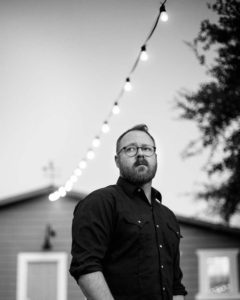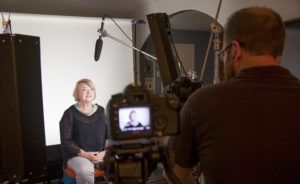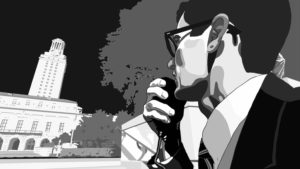
On the morning of August 1, 1966, former Marine sharpshooter Charles Whitman ascended a University of Texas at Austin tower and began random targeting and firing upon passerby below across five city blocks for 96 chilling minutes. When he was finally killed by a policeman, Whitman had already shot 43 people, 13 of whom were killed. Now, 50 years later, Austin-based filmmaker Keith Maitland presents his documentary Tower, an intricate mix of recreations told through animation with dramatized audio interviews, actual news footage from that day in 1966, and other dynamic audiovisual elements. For his efforts, Tower has been nominated as Best Documentary of 2016 for this February 26th’s Oscar ceremony.
Recently, Maitland explained how he envisioned assembling this non-traditional innovative approach to a documentary film about real events. “The concept was set fairly early on,” he said by phone from Austin. “The initial idea was that it would be an animated documentary – between 30 and 45 minutes of animation. As it went on, we wanted to be at the far end of that – 44 minutes of animation.”
Next, Maitland had to determine what exactly he was going to have animated. “I wanted to show multiple perspectives,” he said of his plan in which he wanted audiences to live in the framework of that day in a near real-time feeling. “It began with a ton of research. Over the course of several years, from 2006 to 2012, it was very much a part-time gig of getting into research very intermittently. I would go through months never thinking about the project.”
Through the course of interviewing people about the deadly day, Maitland found that much of his research was inaccurate. “I was the one researching, and I was discovering that people in Austin where I live had a lot of inaccuracies,” he said. “It made me want to double my efforts. People would say, ‘My uncle was there that day.’ I would track those people down and start conversations. A lot of people had a tangential relationship to it, but they all gave me context. That was the research phase.”
 Once the director, 40, made a commitment to the project in 2012, he needed to track down and interview the survivors who were on the ground that day. “After deciding which interview would make up the narrative of the film, I edited those into story beats,” he revealed. “Using those, I wrote a screenplay. It reads like any movie screenplay except everything is verifiable from the mouths of the people who were there. The interviews were much more in depth – what they saw, what they felt, what were they wearing. As much detail as they can possibly get.”
Once the director, 40, made a commitment to the project in 2012, he needed to track down and interview the survivors who were on the ground that day. “After deciding which interview would make up the narrative of the film, I edited those into story beats,” he revealed. “Using those, I wrote a screenplay. It reads like any movie screenplay except everything is verifiable from the mouths of the people who were there. The interviews were much more in depth – what they saw, what they felt, what were they wearing. As much detail as they can possibly get.”
With his screenplay designed to represent the first hour of the film, Maitland decided on one particular orientation – the 2012 interviews would be re-recorded by dramatic actors portraying the actual ages of the people in 1966. “I wanted to make a film which would appear to young audiences,” he expressed. “From the outset, that was our goal; I wanted the film as close to what it would feel like to be stuck in that scenario — a real punch to the gut. That didn’t all come at once, but a lot of it came from the initial inception. I wanted to lay out the animation in a way [where] we could show the action and have the interview describe it.”
After trips to University of Texas, right where Maitland has spent his formative years, he came up with a visual concept for the film. “I was visualizing these locations, these characters,” he stated. “I wanted to capture that feeling authentically—to feel right at home. I also wanted people who had no connection to the university to feel drawn in. Part of the challenge in crafting the screenplay was like editing the documentary on paper. We needed to fill these recreations, but I was going to hand off to the archival footage after the sniper was taken down. We had a complex plan for production with no ending.”
With his shooting script, Maitland cast actors to portray the roles of people actually on the scene with a pipeline to create rotoscopic animation. “It’s such a great tool to tell a human story through a disarming lens,” he said. “People worry that it will keep the humanity at arms length – the opposite is true. The animation team would make sure that the humanity of those actors’ portrayals would carry through.”

Since the University of Texas did not approve recreating that harrowing day on their campus, Maitland use a low-tech approach to filming dramatic August 1, 1966 scenes. “I didn’t have the budget to do a real live-action shoot,” he said. “For the most part, we shot on my backyard and stole some scenes in nearby buildings that approximated the tower’s dimensions. For the interiors of the school, we used my office and my house. We had a lot of fun. I’m also an art director on the film; I got to have my hands in a lot of the wardrobe and props. All of the extras are friends and family, interns, colleagues.”
Another striking element about Tower is that viewers are treated to a variety of points-of-view upon the same exact events from various points around the UT tower area. “I’m excited about the idea about telling a story from multiple perspectives,” said Maitland who had access to an actual local radio broadcast from that day in addition to silent 16mm film footage from a passerby. “In this story, there are so many witnesses; it isn’t any one person’s story. As we cut from character to character, so many opportunities arose. The men who filmed that 16mm footage… I would never see them though we would see so much through their eyes. We had an hour’s worth of the audio from the radio broadcast — I wanted to use it because it was so descriptive.”
 In an example of matching newly filmed recreations with archival film footage and audio from the radio broadcast, Tower presents a moment which defies description when one first views it. “My editor, Austin Reedy, was looking at that silent 16mm footage,” said Maitland. “There’s a couple of [16mm] shots of a car. Austin poked his head in and said that he was able to sync up that radio [broadcast] with those shots. The shots are less than two seconds each – there are three of them. This was a perfect example of intercutting the animation with the archival.”
In an example of matching newly filmed recreations with archival film footage and audio from the radio broadcast, Tower presents a moment which defies description when one first views it. “My editor, Austin Reedy, was looking at that silent 16mm footage,” said Maitland. “There’s a couple of [16mm] shots of a car. Austin poked his head in and said that he was able to sync up that radio [broadcast] with those shots. The shots are less than two seconds each – there are three of them. This was a perfect example of intercutting the animation with the archival.”
With an animation team which started out with three-to-six people for the first 12 months, the final six months were completed with 18 people. As the final project came together, Maitland had a new perspective on the work. “I always think of Tower as a Western,” he conveyed. “Town square, onlookers, replace saloon with student union. Cowboys and villains with snipers and heroic people. It plays out like the big climax of Vertigo.”
As the film has rolled out and is now up for a Best Documentary Oscar, Maitland is pleased that Tower is reaching a sizable audience. “People relate to the story because they’re drawn in by the aesthetic decisions we made,” he said. “To see the response is so heartening. Every time we make an impact on somebody, it means that many more people are going to see it.”





